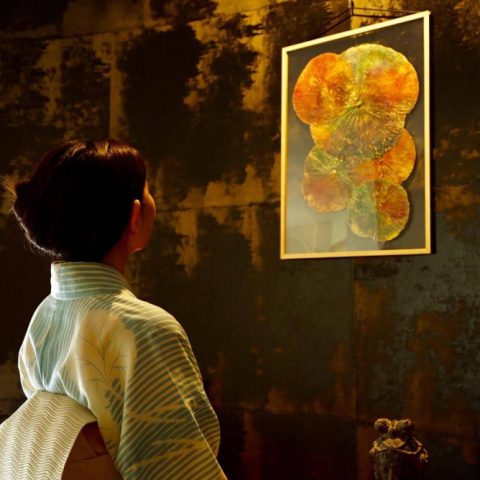
The team here at Arigato Travel recently had the privilege of meeting with the team at Genji Kyoto a new boutique hotel. Having just opened their doors to the world, we knew we had to introduce them on our blog.
Hi Genji Kyoto team! Could you please introduce yourselves for us?
Hello. My name is Mao Yamaguchi and I am very happy to be the General Manager looking after Genji Kyoto. Isao is our Operations and Food and Beverage Manager, he returned to Japan after many years in Australia. Murat, our Executive Chef, is from Turkey but has lived and worked in hotels in Kyoto for many years. Koko, our Guest Experience Manager, and myself are both from Kyoto. We, and the rest of our team, are here to help guests experience the best of Kyoto while feeling at home.

Why is the hotel named Genji Kyoto?
It is, above all, a tribute to our location. A short walk from the hotel is the site that once held the garden mansion used as the model residence in the classic novel, the Tale of Genji. The mansion’s owner was nobleman Minamoto no Toru, said to be the model for the novel’s Prince Genji character. Given the location and history, and also the important place that the Tale of Genji occupies in Japanese literature, we felt that the name Genji Kyoto can spark greater appreciation for the origins of this 1000-year-old classic.

In your view, why is the Tale of Genji such an important cultural piece?
The Tale of Genji and the pictorial scrolls it inspired provide valuable documentation for Japan’s early sources of aesthetics, architecture and gardens dating back a millennium. The images and metaphors used in the Heian period novel have been a source of inspiration for Japanese artistic expression ever since, appearing as motifs in paintings, screens, art objects, furnishings and costumes throughout the centuries.
How are you expressing these motifs in your hotel?
In our lobby we have the Ukifune Garden, a karesansui garden with a boat-like stone carrying a patch of moss representing the “drifting boat” metaphor from the Tale of Genji. In the novel, the boat represents the untethered evanescence of human experience. In our garden it is also a metaphor for our own planet earth drifting through the universe.
Then we have handmade furniture also inspired by the Ukifune motif, as well as by flower metaphors. Our centrepiece Tachibana Table draws inspiration from the shape of orange blossoms.
In our rooms, we have paintings by young Kyoto artists who showed us their own interpretation of metaphors in the novel. Nature and the seasons not only filled the poetry and drove festivities in the Tale of Genji, but were also metaphors for the characters and their palace quarters.
The small private gardens throughout the hotel, called tsubo gardens, hark back to gardens created in the Tale of Genji era. In the novel, the court ladies who lived next to such a tsubo garden took the featured plant in that garden as their own name, and thus we find Fujitsubo named for the wisteria, and Kiritsubo, named for the paulownia. Some of these became the names of our rooms, which we engrave on the doors together with corresponding incense symbols that gained popularity as a Genji game.

Having just opened to the public, what food are you offering to your guests at the hotel?
We are offering a very attractive mix of Japanese and international dishes designed to bring comfort and joy. All dishes can be served in our atmospheric Genji Lounge in the lobby, in our Sky Forest Garden on the roof (weather permitting), or in the comfort of the guest’s own room.
For a start, we have sumptuous breakfasts all freshly cooked, including Continental, Western and Japanese sets, as well as a la carte dishes with vegetarian choices.
For all-day dining we have small plates, simple hearty fare and very tempting desserts. Some examples are our Mezze Plate with Middle Eastern dips, Japanese appetizers, a juicy teriyaki burger, a Wagyu steak sandwich, Donburi (Wagyu, fish, or vegetarian), and a healthy salad and soup made with the most seasonal Kyoto leaves and vegetables.

What dish would you suggest to best complement the ambience and atmosphere your hotel provides?
Definitely our Ukifune Appetizer Plate. Whether sitting in the lobby by our serene courtyard garden, or enjoying sunset views on our rooftop garden, what better compliment than a drink in hand with delectable morsels made from the freshest ingredients of the day. I would recommend topping that off with a Warm Hojicha Fondant, or a more traditional Uji Matcha Trio. For a gluten free option, we have an exquisite soft Chiffon Cake.
Having such a diverse range of cultures on your team, what, do you feel, is the greatest advantage this provides?
We do have a diverse, multi-cultural team from designers to operational staff and this is a very welcome asset for the hotel. We get different perspectives and more creative ideas. Everyone brings something new to the table. We get to learn so much from people with different backgrounds and life experiences. It helps us to understand the needs and better interact with our guests, who also come from different places and cultures.

Why did you choose the Gojo-Kawaramachi area as the location for your hotel? What do you think makes it such a great neighbourhood?
This is such a great location, right in the heart of Kyoto and between two beautiful rivers, giving us great views. It is just a 20 minute walk to Kyoto’s major attractions such as Gion, Pontocho, Nishiki Market and Kyoto Station shopping, both tranquil, and slightly bohemian. We have around us original machiyas, retro cafes, and workshops, even a century-old bathhouse! This neighbourhood has history and character, and local street life that gives it a nice communal feel.
What suggestions do you have for the tourists visiting the area?
We have a Walking Map to show guests all the interesting cafes, restaurants and bars around us within a 15-minute walk. We also have a Greater Neighbourhood Map that shows the temples, gardens, shops, sights and restaurants all with a 30-minute walk or a short taxi ride. For those still new to Kyoto, definitely not to be missed are the Gion, Kiyomizudera, Ninenzaka and Sannenzaka, National Museum and its nearby temples, and the beautiful gardens of Shosei-En and Higashi Honganji. For somewhere more off the beaten track, we highly recommend the Namikawa Cloisonne Museum of Kyoto, a garden residence that is as exquisite as the cloisonne (enamel) wares that it houses.

With the hotel’s grand opening all completed, what about the hotel are you most excited to introduce to your guests?
We are excited for guests to come and experience Genji Kyoto as a sanctuary of beauty and comfort. From our bamboo-lined entrance to the serene garden in the lobby, up to our Sky Forest Garden on the roof, every detail is designed to instill the quiet delight that emanates from true Japanese ambiance. Guests will find our rooms spacious and comfortable with great, and hopefully that our service will live up to the omotenashi, Japanese hospitality, that Kyoto prides itself on.
Thank you so much for taking the time to talk to us today about your hotel! We truly appreciate the chance to be able to introduce your team to our readers.
Follow Genji Kyoto Hotel on:
Website: https://genjikyoto.com
Instagram: @genjikyoto
Facebook: @GenjiKyotoHotel
Twitter: @GenjiKyoto
Tiktok: @Genji Kyoto
Want to book a stay at this hotel? You can do so here!
Interested in an authentic experience with a local before staying at Genji Kyoto? Book our food tours in Kyoto with us!
PIN FOR THIS LATER





